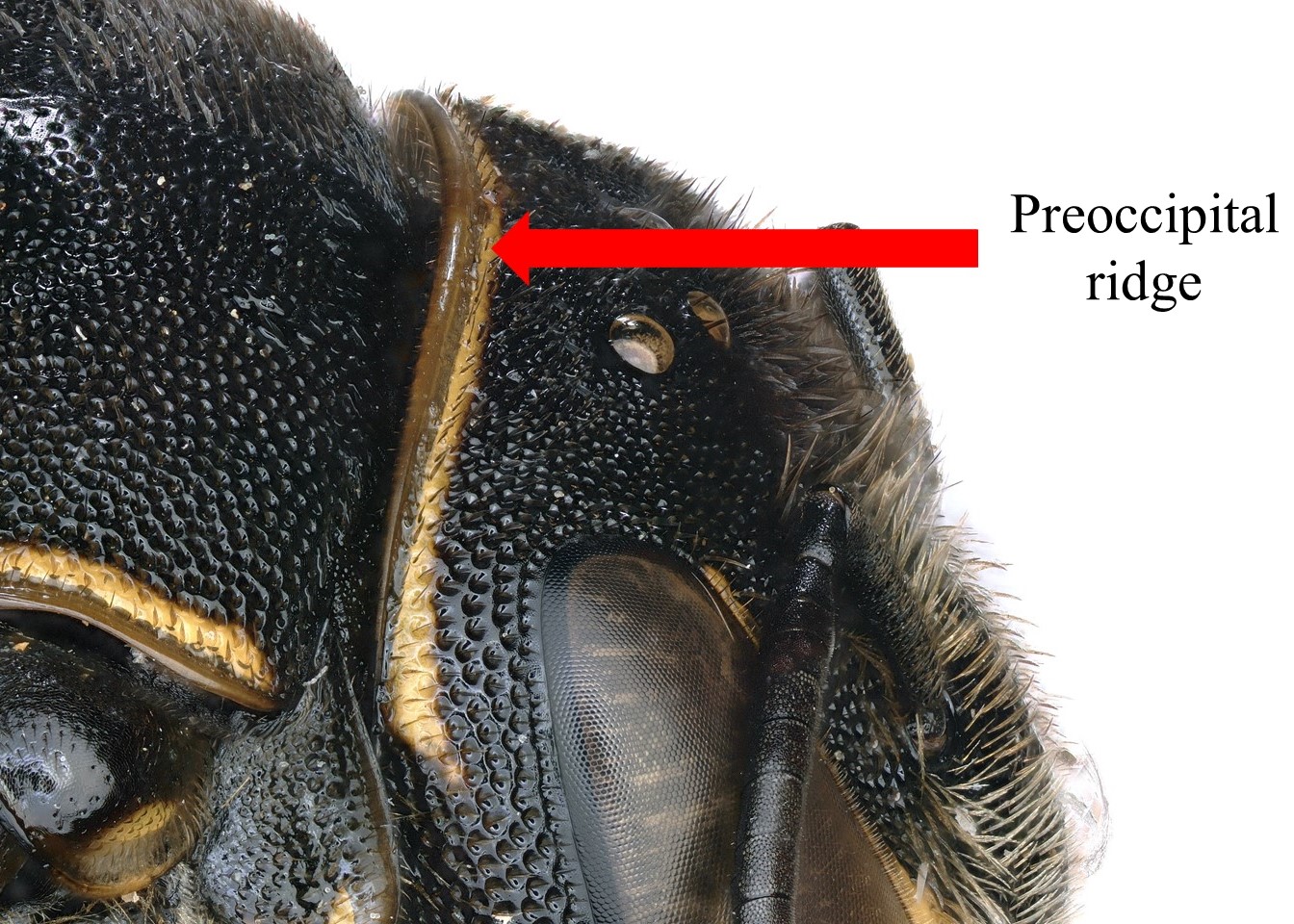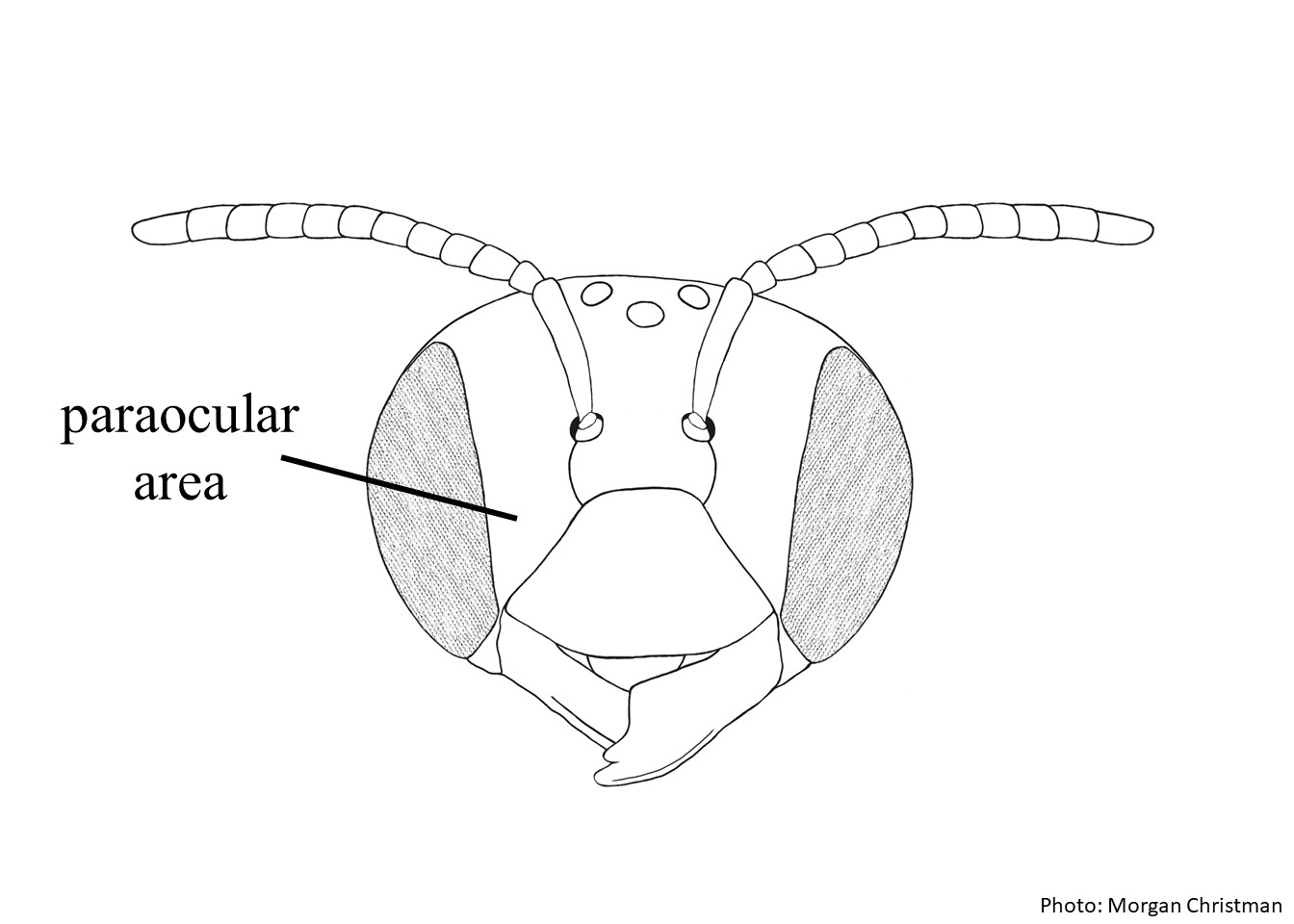Family: Apidae
Subfamily: Xylocopinae
Tribe: Ceratinini
Genus: Ceratina Latreille, 1802
Subgenus: Dalyatina Terzo et al., 2007
Common name: small carpenter bees
The subgenus Dalyatina consists of small to large carpenter bees, often with entirely black integumentintegument:
a tough, protective outer layer
, but if pale markings are present they are limited to the clypeusclypeus:
a section of the face below the antennae, demarcated by the epistomal sutures, labrumlabrum:
part of the head abutting the clypeus, folds down in front of the mouthparts
 , pronotal lobes, and the base of the tibiatibia:
, pronotal lobes, and the base of the tibiatibia:
the segment of the leg, between the femur and the tarsus (Terzo et al. 2007Terzo et al. 2007:
Terzo M., S. Iserbyt, and P. Rasmont. 2007. Reacute;vision des Xylocopinae (Hymenoptera: Apidae) de France et de Belgique. Annales de la Socieacute;teacute; Entomologique de France 43 (4): 445‒491.). They range in body length from 5–10 mm (Smith 1854Smith 1854:
Smith, F. 1854. A Catalogue of Hymenopterous Insects in the collection of the British Museum. Part II, Apidaelig;. Taylor and Francis, Red Lion Court, Fleet Street, London:199‒465., Friese 1905Friese 1905:
Friese, H. 1905. Die Keulenhornbienen Afrikas Genus Ceratina . Wiener entomologische Zeitung 24: 1ndash;24.).
(modified from Terzo et al. 2007Terzo et al. 2007:
Terzo M., S. Iserbyt, and P. Rasmont. 2007. Reacute;vision des Xylocopinae (Hymenoptera: Apidae) de France et de Belgique. Annales de la Socieacute;teacute; Entomologique de France 43 (4): 445‒491.)
 rounded.
rounded.Ceratina (Dalyatina) can be confused with Ceratina (Ceratina) because of the large impunctateimpunctate:
marked with punctures or pits
areas of their face and their black integumentintegument:
a tough, protective outer layer
with pale markings limited to the face, pronotal lobes, and tibiatibia:
the segment of the leg, between the femur and the tarsus. Both sexes of C. (Dalytina) can be separated by the more widely extensive impunctateimpunctate:
marked with punctures or pits
areas on the face, whereas the impunctateimpunctate:
marked with punctures or pits
areas on the face of C. (Ceratina) are usually limited to the paraocularparaocular:
the area extending along the sides of the face parallel to the eye
 areas. In addition, species of C. (Dalyatina) in both Africa and Europe can be separated from other subgenera because of the characters of the male genitaliagenitalia:
areas. In addition, species of C. (Dalyatina) in both Africa and Europe can be separated from other subgenera because of the characters of the male genitaliagenitalia:
all the genital structures collectively
mentioned in the diagnosis above.
Ceratina (Dalyatina) are generalists and have been observed visiting a wide variety of flowers including Eryngium campestre (Apiaceae), Centaurea solstitialis (Asteraceae), Centaurea seridis (Asteraceae), Echium vulgare (Boraginaceae), Lavandula x intermedia (Lamiaceae), Lavandula latifolia (Lamiaceae), Scabiosa atropurpurea (Caprifoliaceae), and Rubus ulmifolius anatolicus (Rosaceae) (Saunders 1908Saunders 1908:
Saunders E. 1908. Hymenoptera aculeata collected in Algeria by the Rev. A. E. Eaton, M.A., F.E.S. Part III. Anthophila. Transactions of the Entomological Society of London 12: 177‒274.; Mavromoustakis 1949Mavromoustakis 1949:
Mavromoustakis, G.A. 1949. On the Bees (Hymenoptera Apoidea) of Cyprus. Part 1. Annals and Magazine of Natural History 12 (1): 541ndash;577.; Le Goff 1995Le Goff 1995:
Le Goff, G. 1995. Ceratina parvula Smith in Rousillon (Apoidea-Xylocopinae). Lrsquo;Entomologiste 51(6): 267‒272.; Terzo et al. 2007Terzo et al. 2007:
Terzo M., S. Iserbyt, and P. Rasmont. 2007. Reacute;vision des Xylocopinae (Hymenoptera: Apidae) de France et de Belgique. Annales de la Socieacute;teacute; Entomologique de France 43 (4): 445‒491.).
Ceratina (Dalyatina) parvula has been found nesting in the stems of Rubus sp. (Rosaceae), Rhus coriaria (Anacardiaceae), Anchusa sp. (Boraginaceae), Echium sp. (Boraginaceae), and Asphodelus sp. (Liliaceae) (Lichtenstein 1876Lichtenstein 1876:
Lichtenstein J. 1876. Observation agrave; propos de la Revue critique des espegrave;ces du genre Ceratina Lat. (Hymeacute;noptegrave;res) de M. H. Tournier. Petites Nouvelles Entomologiques 2: 90pp.; Mavromoustakis 1949Mavromoustakis 1949:
Mavromoustakis, G.A. 1949. On the Bees (Hymenoptera Apoidea) of Cyprus. Part 1. Annals and Magazine of Natural History 12 (1): 541ndash;577.; Terzo et al. 2007Terzo et al. 2007:
Terzo M., S. Iserbyt, and P. Rasmont. 2007. Reacute;vision des Xylocopinae (Hymenoptera: Apidae) de France et de Belgique. Annales de la Socieacute;teacute; Entomologique de France 43 (4): 445‒491.).
Ceratina (Dalyatina) contains four species: C. parvula Smith 1854Smith 1854:
Smith, F. 1854. A Catalogue of Hymenopterous Insects in the collection of the British Museum. Part II, Apidaelig;. Taylor and Francis, Red Lion Court, Fleet Street, London:199‒465., C. aloes Cockerell 1934, C. subquadrata Smith 1854Smith 1854:
Smith, F. 1854. A Catalogue of Hymenopterous Insects in the collection of the British Museum. Part II, Apidaelig;. Taylor and Francis, Red Lion Court, Fleet Street, London:199‒465., and C. truncata Friese 1905Friese 1905:
Friese, H. 1905. Die Keulenhornbienen Afrikas Genus Ceratina . Wiener entomologische Zeitung 24: 1ndash;24. (Ascher and Pickering 2020Ascher and Pickering 2020:
Ascher, J.S. and J. Pickering. 2020. Discover Life bee species guide and world checklist (Hymenoptera: Apoidea: Anthophila). https://www.discoverlife.org/mp/20p?see=Carinulaamp;name=Megachileamp;flags=subgenus :).
There no known invasives.
Ceratina (Dalyatina) occurs mostly in the sub-Saharan region in Africa, but one species occurs in the Mediterranean (Terzo et al. 2007Terzo et al. 2007:
Terzo M., S. Iserbyt, and P. Rasmont. 2007. Reacute;vision des Xylocopinae (Hymenoptera: Apidae) de France et de Belgique. Annales de la Socieacute;teacute; Entomologique de France 43 (4): 445‒491.).

Distribution map generated by Discover Life -- click on map for details, credits, and terms of use.
Ascher, J.S. and J. Pickering. 2020. Discover Life bee species guide and world checklist (Hymenoptera: Apoidea: Anthophila). Accessed 1-Sep-2020, https://www.discoverlife.org/mp/20p?see=Dalyatina&name=Ceratina&flags=subgenus:
Le Goff, G. 1995. Ceratina parvula Smith in Rousillon (Apoidea-Xylocopinae). L’Entomologiste 51(6): 267‒272.
Lichtenstein J. 1876. Observation à propos de la Revue critique des espèces du genre Ceratina Lat. (Hyménoptères) de M. H. Tournier. Petites Nouvelles Entomologiques 2: 90pp.
Mavromoustakis, G.A. 1949. On the Bees (Hymenoptera Apoidea) of Cyprus. Part 1. Annals and Magazine of Natural History 12 (1): 541–577.
Michener C.D. 2007. The Bees of the World (2nd ed.). Johns Hopkins University Press, Baltimore and London, 953 pp.
Saunders E. 1908. Hymenoptera aculeata collected in Algeria by the Rev. A. E. Eaton, M.A., F.E.S. Part III. Anthophila. Transactions of the Entomological Society of London 12: 177‒274.
Smith, F. 1854. A Catalogue of Hymenopterous Insects in the collection of the British Museum. Part II, Apidæ. Taylor and Francis, Red Lion Court, Fleet Street, London:199‒465.
Terzo M., S. Iserbyt, and P. Rasmont. 2007. Révision des Xylocopinae (Hymenoptera: Apidae) de France et de Belgique. Annales de la Société Entomologique de France 43 (4): 445‒491.